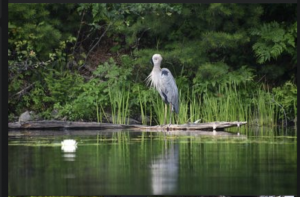Landowner Best Practices 
As an owner on Lake Owen, you are privileged to experience one of the highest quality waters in the region and are surrounded by abundant natural beauty and wildlife. Our deep, clear lake is fed by groundwater, and runoff from rainwater is filtered by the forestland surrounding much of the lake.
We can all do our part to protect this pristine treasure, and it starts with appreciating the lake and evaluating our potential impacts. One of the most important considerations is how runoff water travels from your property. Runoff carries nutrients and sediment to the lake. Nutrients – phosphorus in particular – increase algae growth. It takes only 1 pound of phosphorus to grow 500 pounds of algae! Sediment can carry nutrients and smother habitat in the lake.
While forest and wetlands protect the lake by absorbing runoff, hard surfaces like roofs, driveways, parking areas, and sidewalks greatly increase the flow of water. Lawns, with short stems and shallow roots, do little to slow the flow or intercept nutrients and sediment. Native vegetation close to the water acts as a buffer to slow runoff and also provides critical habitat. 
So, what can you do?
Evaluate your property.
An online tool is available to help.
The Shoreland Evaluation Tool walks you through questions about the physical aspects of your property, as well as how you manage it. At the end, it provides customized suggestions for measures to protect the lake.
A Self-Evaluation Checklist for Waterfront Runoff is also available to assess the need for water quality improvements on your property. It will help you analyze water flow patterns and sources of runoff on your parcel and consider potential solutions to runoff problems.
Would you rather have in-person, on-site assistance? 
Your Lake Owen Association Lake Manager, Cheryl Clemens, is available for free consultations.
Contact Cheryl at harmonyenv@amerytel.net or 715-225-0690.
Follow Best Practices to Protect the Lake.
- Support natural vegetation next to the water. Consider converting lawn to natural vegetation.
- Appreciate and protect the vegetation in the water. It provides essential habitat for creatures in the lake. From the zooplankton that feed the fish to the waterfowl swimming on the surface – all depend on plants in the water.
- Where there is lawn, set the mower blade higher, or consider no-mow lawn grass. Do not use phosphorus fertilizers or pesticides near the lake.
- Divert water from hard surfaces to well-vegetated areas.
- Be sure your contractor installs erosion control practices, such as properly installed silt fence, to prevent erosion during construction.
Consider native plantings, rain gardens, and/or rock infiltration to absorb and filter runoff where there are areas of channelized flow and erosion near the lake. To learn more about these practices go to: https://healthylakeswi.com/best-practices/
Ten Simple Shoreland Stewardship Practices: https://lakeowen.org/wp-content/uploads/2024/07/Simple-Shoreland-Stewardship-2021.pdf
See how you can help lakes in this 8 minute video: Our Lakeshore Connection
See how large wakes affect the lake environment: Wake Surfing


